Following our rides in the Lionhead we took our time wandering through Yellowstone National Park and then over towards our next destination just south of Red Lodge Montana via the Beartooth Highway. We ended up getting a campsite at the Greenough campsites just N of Beartooth Pass.
ProTip. Take your time getting through Yellowstone and be patient but get there early. We were through the West Yellowstone park gate just after 7am and wandered through without hassle. Lineups stretch out 2km+ if you’re just a couple of hours later. Example 1: we were at Grand Prismatic Springs at about 8.30am and biked in to the parking lots and bypassed most of the crowds but as we were living spied the first crush of tour buses coming through. Example 2: we had front row seats and sparse crowds for Old Faithful at 10:30 but the parking lots were getting full when we left closer to noon. Of course crowds are unavoidable and for good reason. Yellowstone is spectacular and it was well worth the languid relaxed touristy drive.
Beartooth Pass and the Line Creek Plateau at approximately 3100m
Perhaps the highlight of the day’s drive was the Beartooth Highway. Approximately 100kms long it winds its way through NW Wyoming from Yellowstone National back to Montana. It’s spellboundingly spectacular and reaches elevations of 3300m + before descending precipitously to valley floor at 1800m.
A summer-only ski area, alarming debris torrent channels, ambitous-looking rock and snow fences and conveniently-placed pullouts for views complete the experience. And what a visual experience it is.
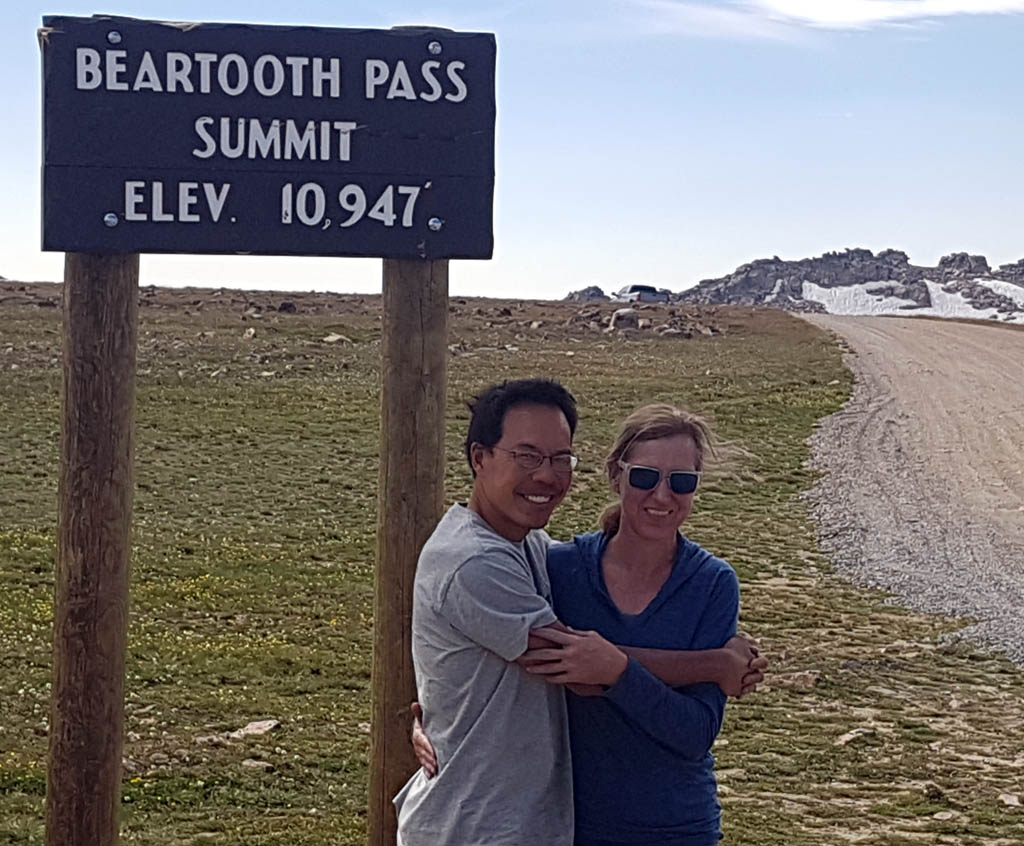
Beartooth Pass tourists. Just a little ways NE of this sign is the Line Creek trailhead parking
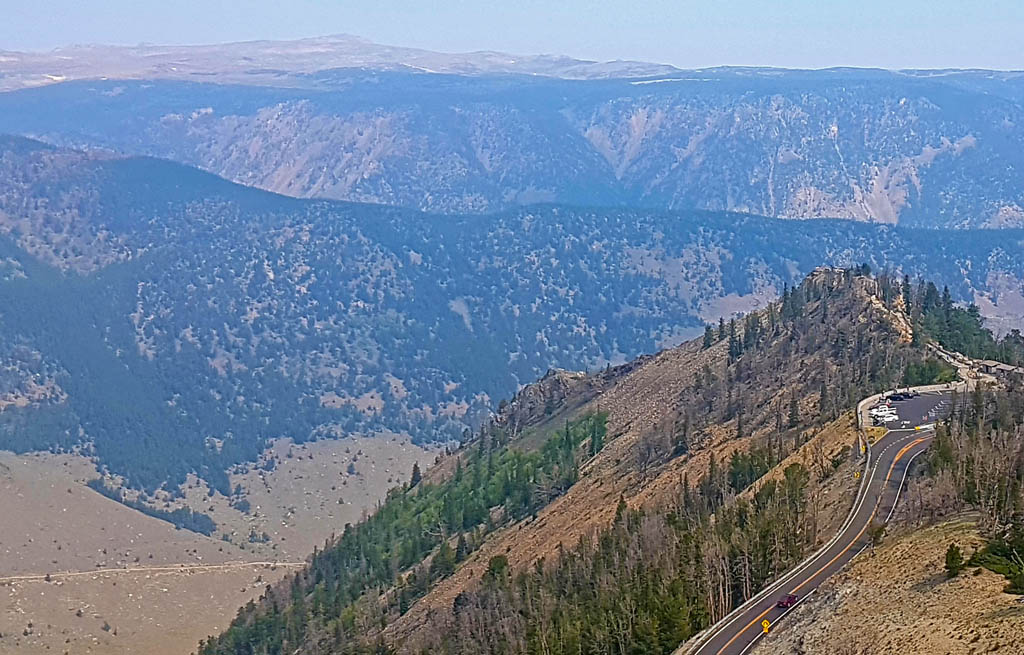
One of many spectacular Beartooth Highway viewpoints
Line Creek Plateau and Beartooth Highway
Sharon Kevin and I had the privilege of riding the Line Creek Plateau aka Beartooth Plateau. We all agreed it was one of the preeminent alpine riding experiences we’ve all collectively had worldwide (and we’ve ridden lots). At 27kms long the trail spends the bulk of its time between 3050m and 2850m on high alpine tundra when we would normally be navigating glaciers and icefields. The last 8km then descends the flanks of Mt Maurice via wonderfully benchcut singletrack with some impressive sharktoothed waterbars.
Line Creek is relatively easy to access as one can drive right to the trailhead. However, there still aren’t many people riding here. One reason is the exceptionally short riding season for the trail; it only melts out in late June/early July and it frequently experiences snowfall in mid – September. Because it’s a high alpine plateau the views are seemingly limitless in every direction. Also because it’s a high alpine plateau weather can come in quickly, without much warning and, without any shelter, trapped parties will be in big trouble. Travel quickly, be aware of where you are and be aware of the limited exit possibilities.
The Line Creek Plateau – Beartooth Pass Montana – August 16, 2018
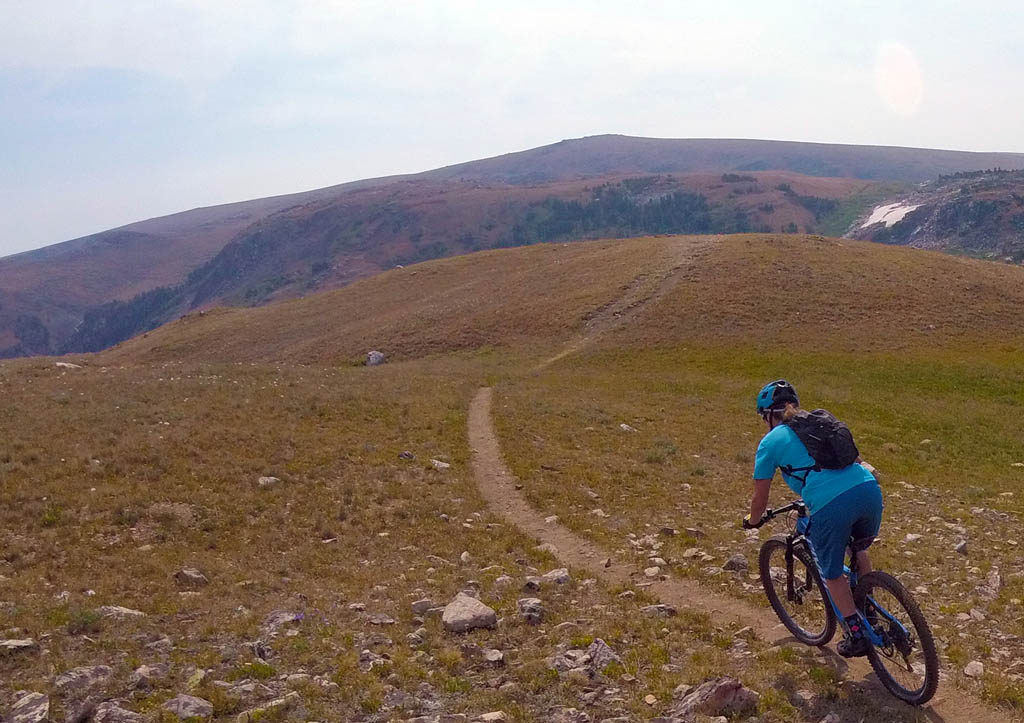
Dropping in at 3100m from the Line Creek trailhead
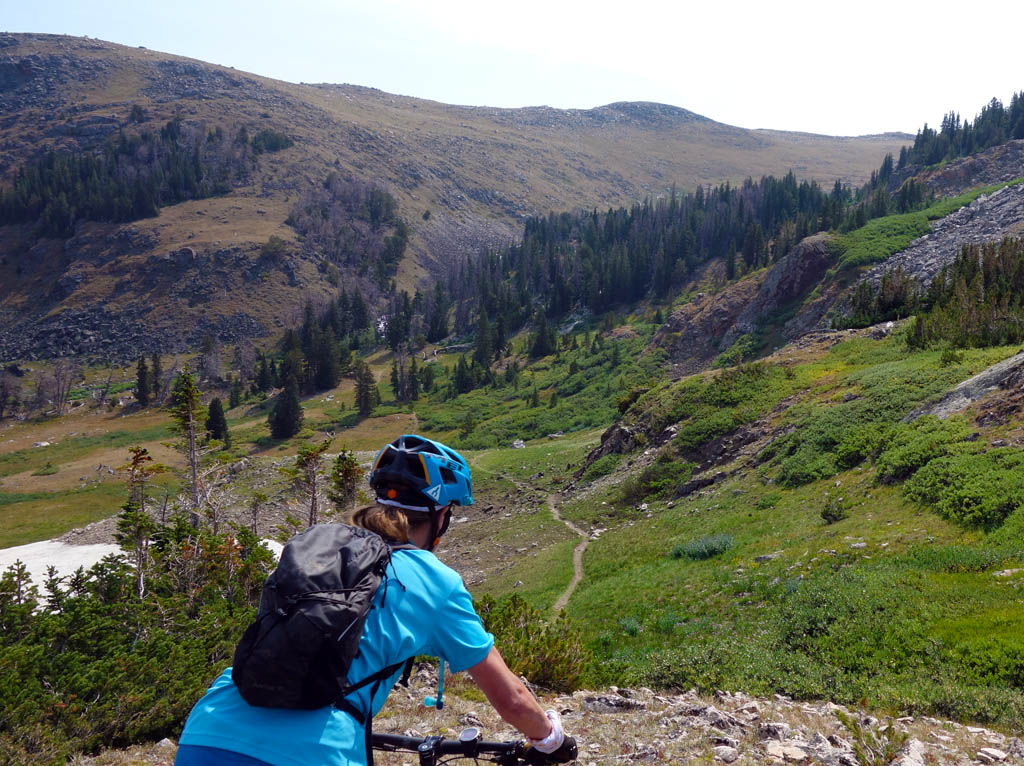
A rerouted section of trail drops to the creekbed instead of climbing the old route to looker’s right to a small knoll
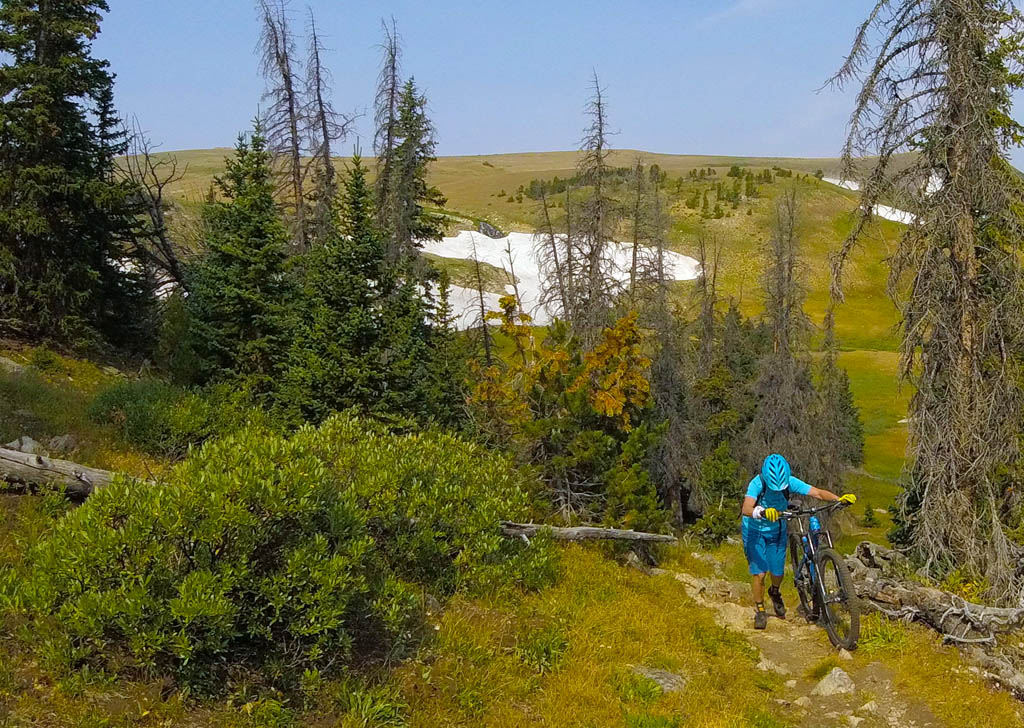
Instead of two small climbs you get one medium climb from 2935m back to 3060m. No big deal but the air feels thin to us
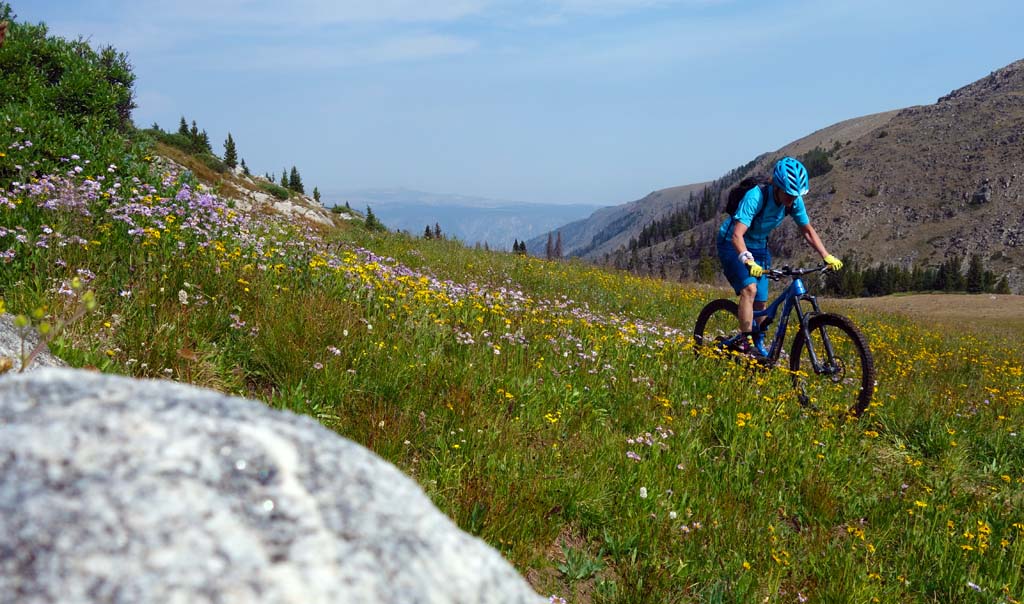
Perfect alpine flower timing
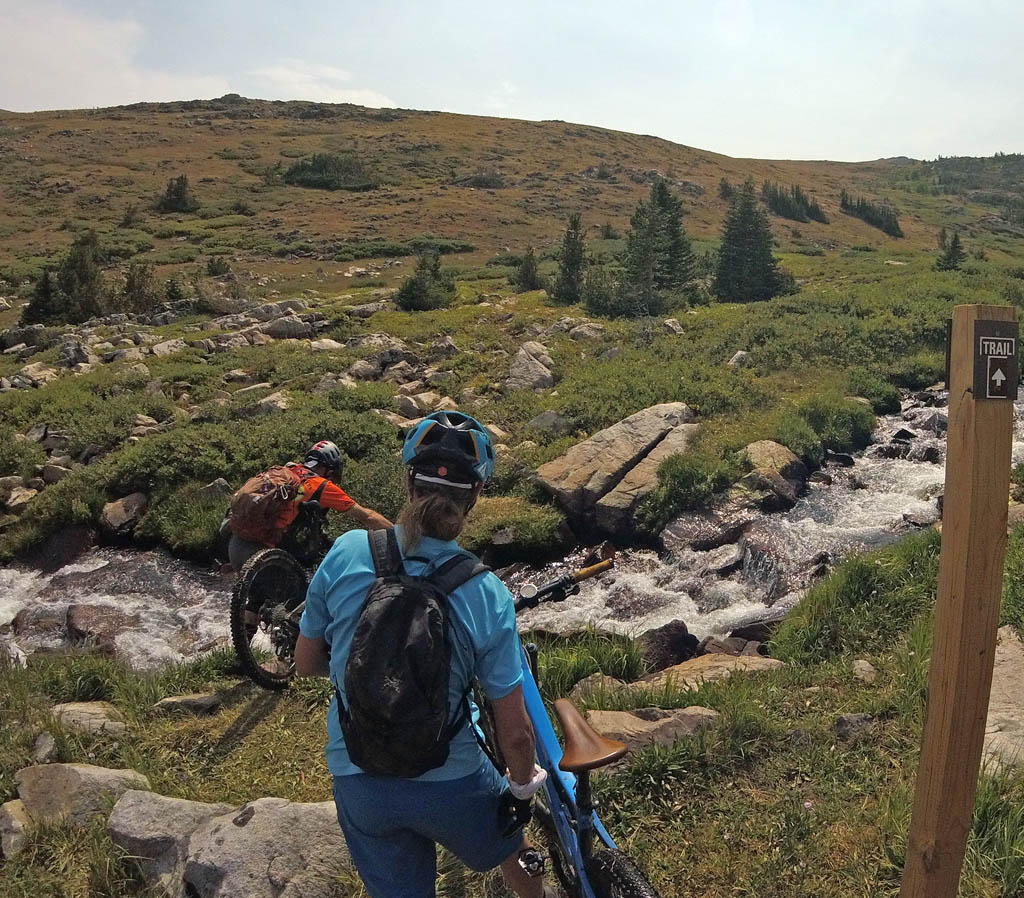
One last minor grind
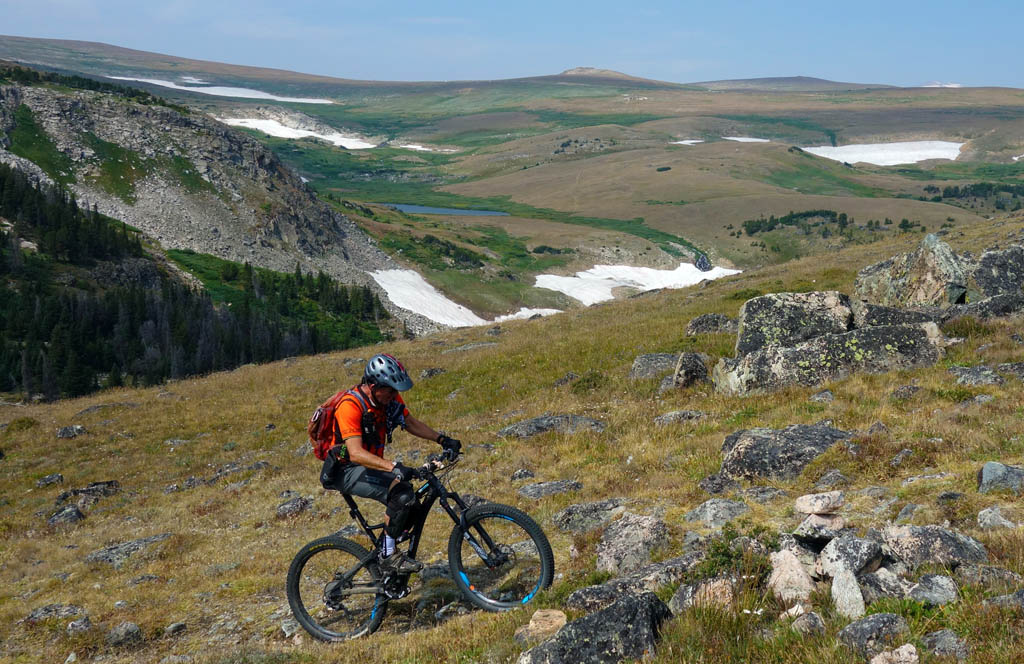
Topping out at approx 3060m following the only meaningful climb of the day
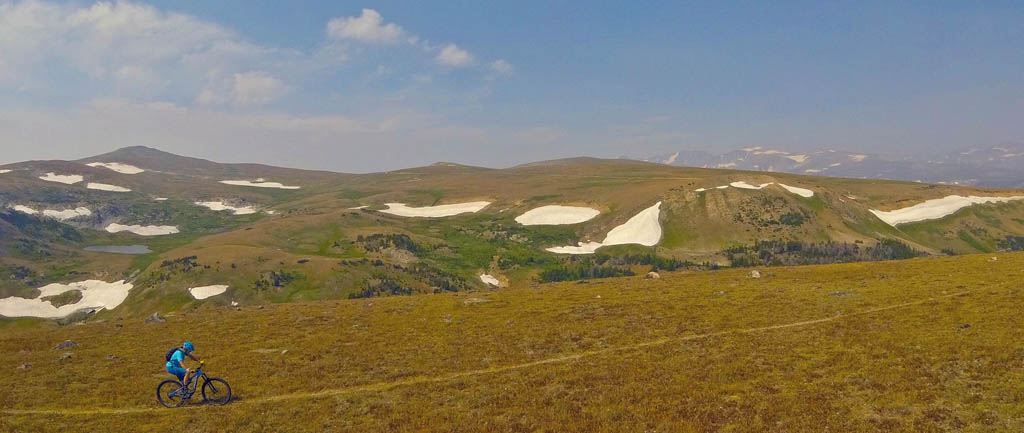
Views that go on forever
Routefinding on Line Creek can be best described as “it depends”. There simply aren’t many users of the trail or the trail network at this elevation. Cairns do mark the route but in places the singletrack is faint and tough to spot although trails are less faint as the season wears on.
I suspect it would be a challenging routefinding exercise if there was still substantial alpine snow. There are quite a few hiking and horsepacking trails wandering off the main route (USFS map describes it here) as well as game and stock trails so don’t be distracted and if in doubt look at your map. The only key junction which may be an issue is the Corral Creek turnoff which cuts out a chunk of alpine riding and drops off prematurely from the ridgeline.
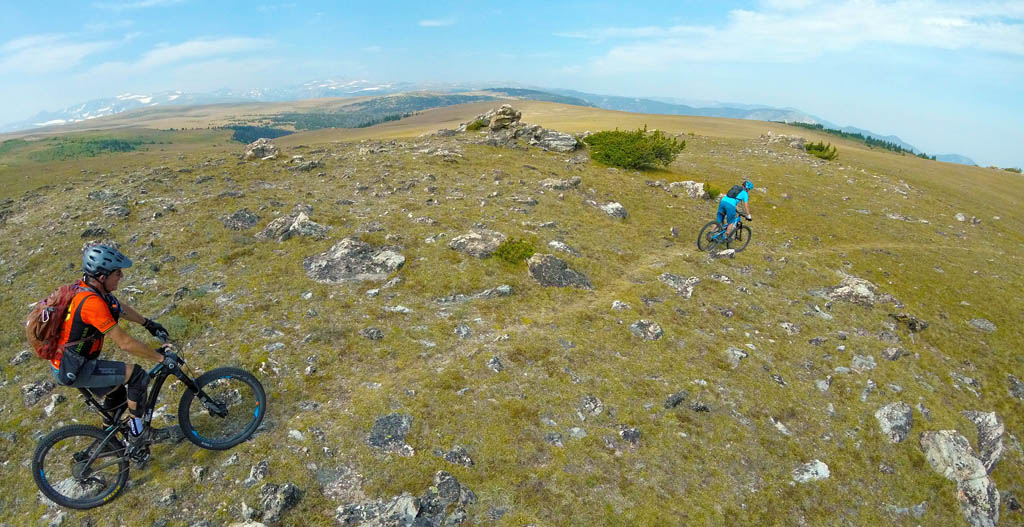
Now starts approximately 16km of pure alpine tundra
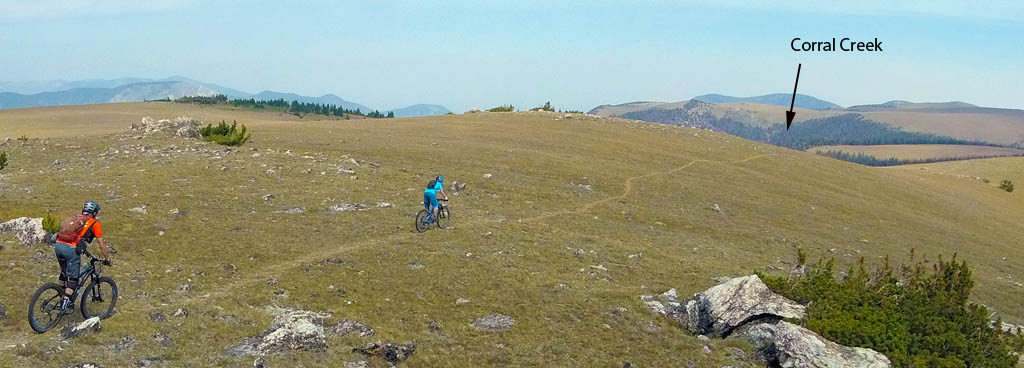
The singletrack in this picture apparently only materializes towards mid summer as the traffic on the trail “grows”. We saw no other people on trail this fine day
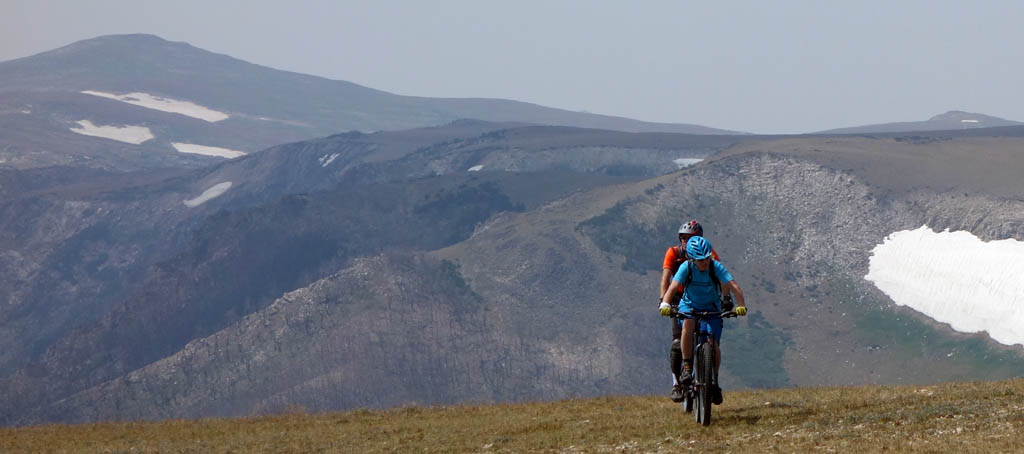
Crossing the Corral Creek drainage and climbing on to the last bit of ridgeline
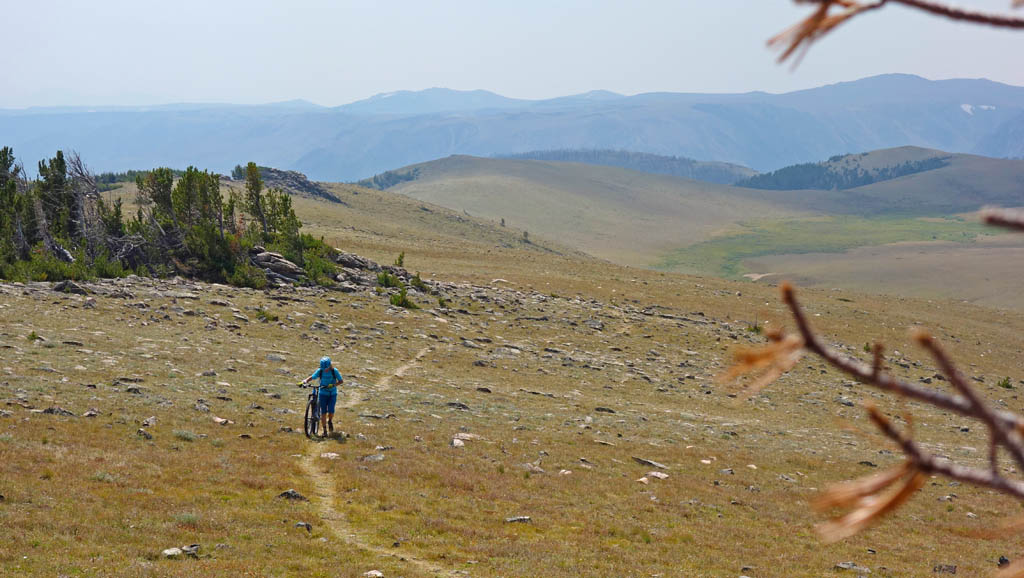
Towards Mt Maurice
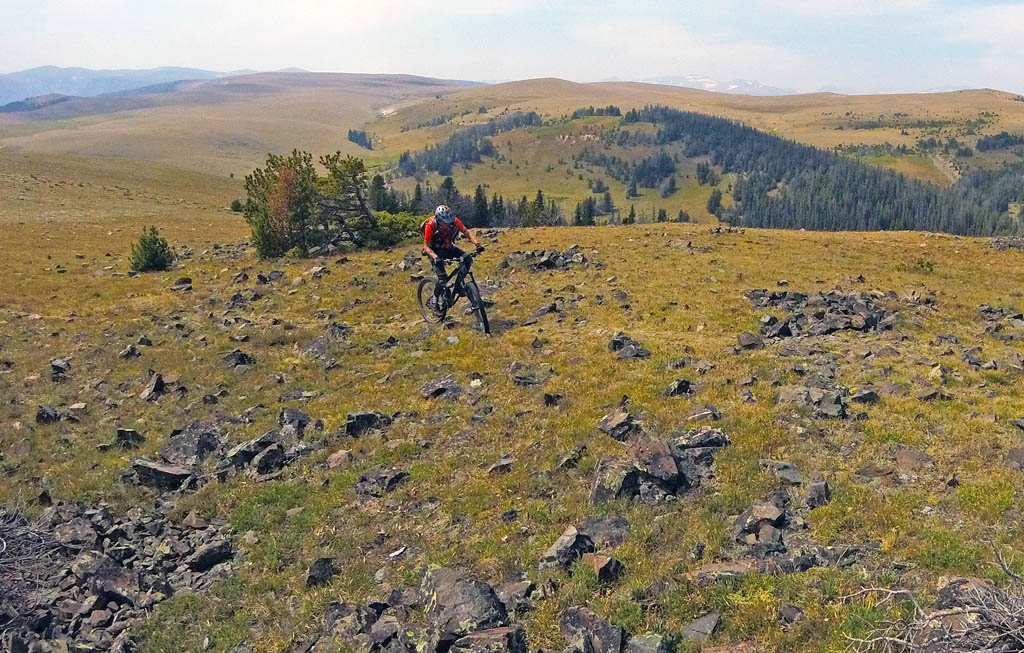
Some volcanic rock action as the Mt Maurice geology kicks in
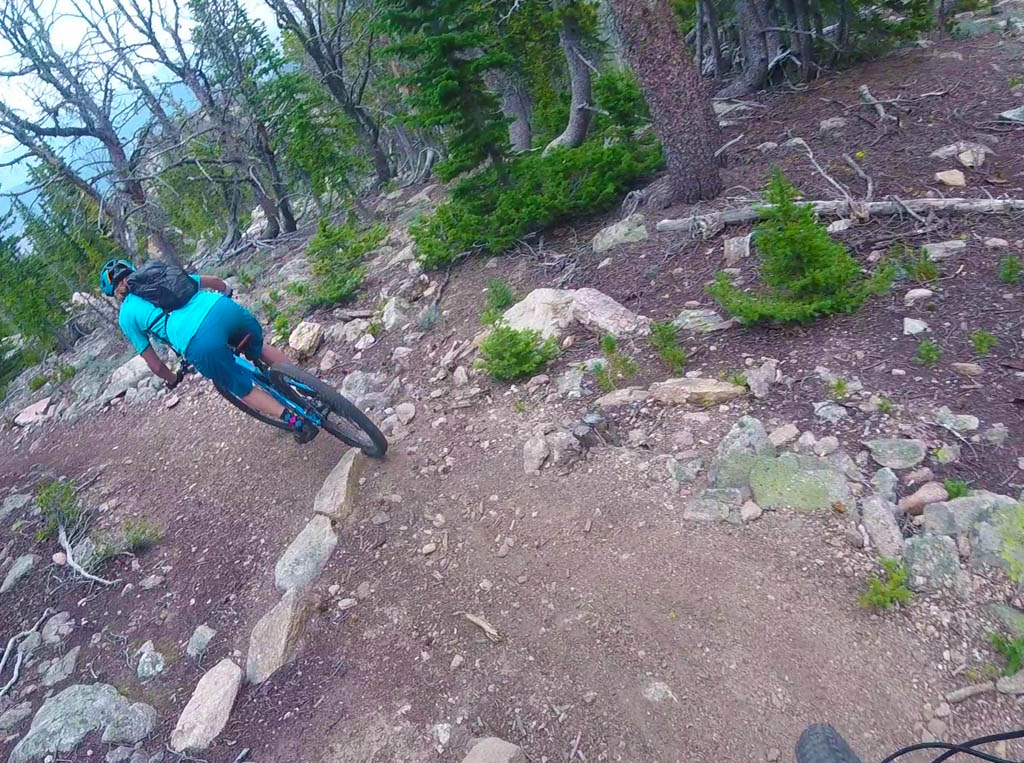
Dropping in on the Mt Maurice trail to complete the Line Creek Plateau
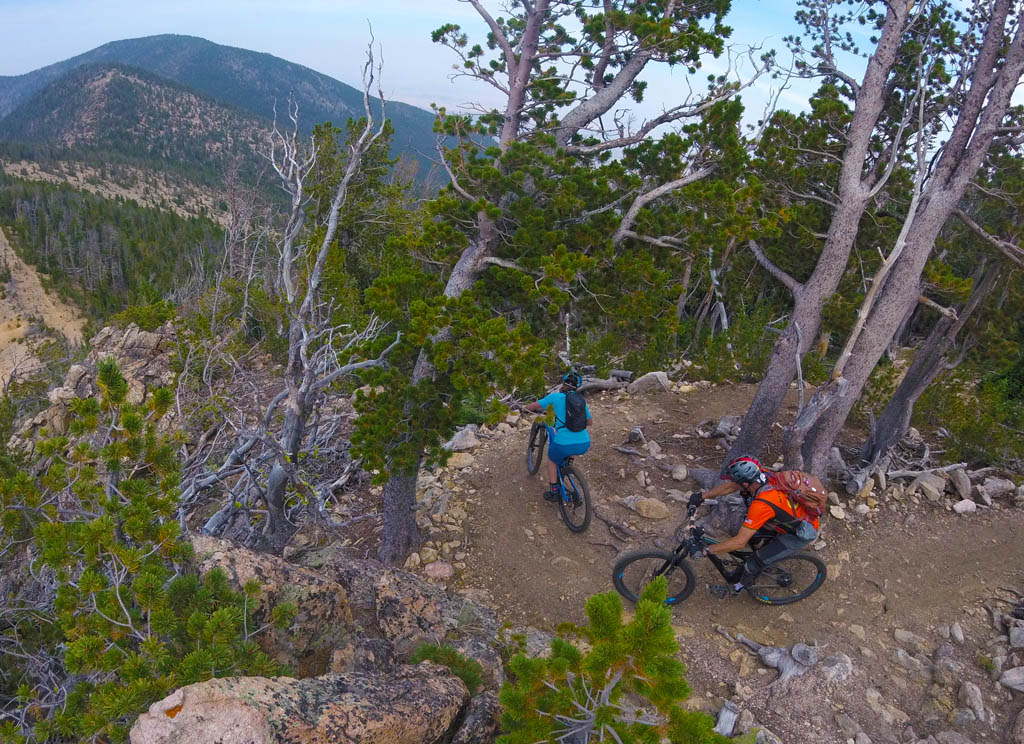
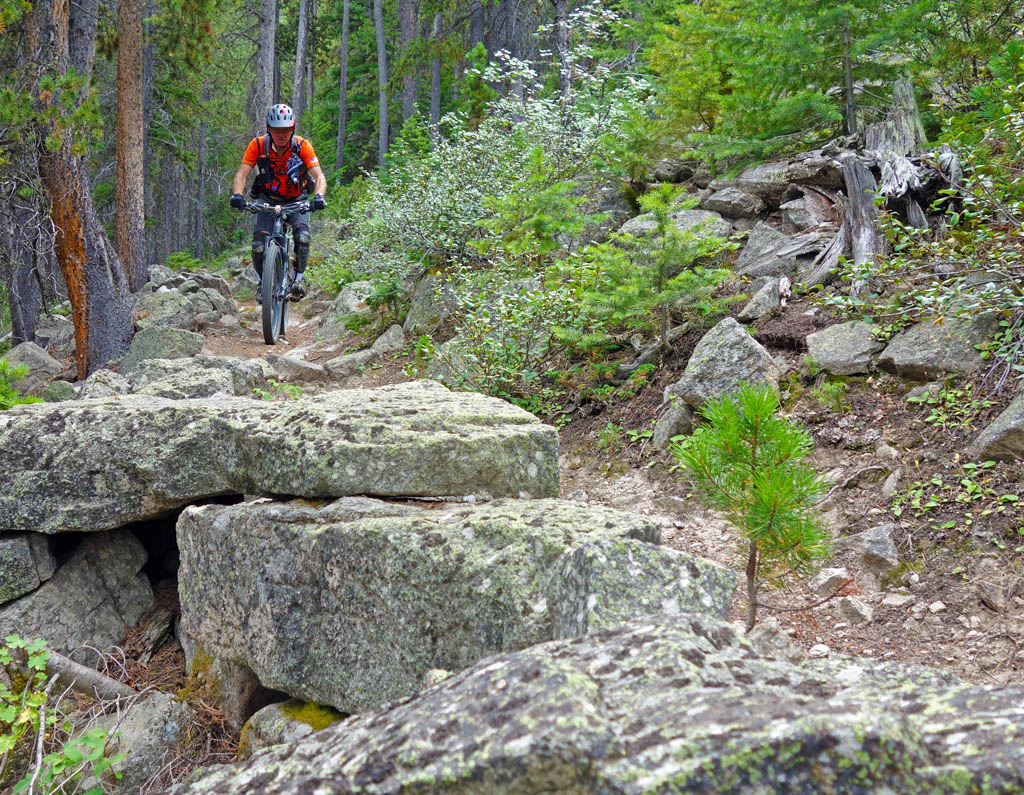
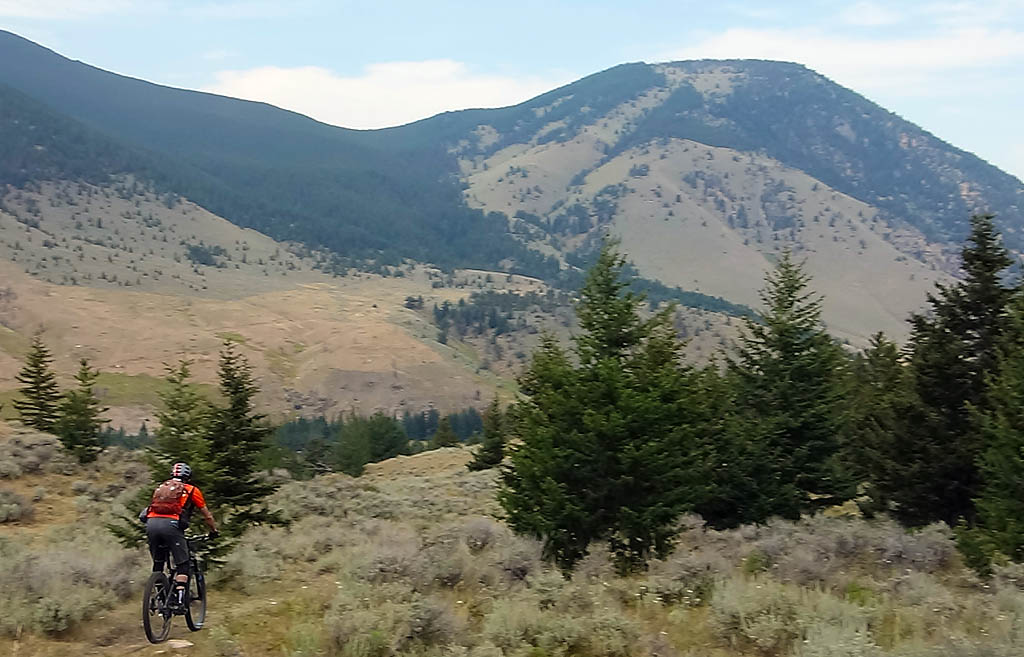
The final descent to valley floor at 1960m as vegetation changes dramatically to conifers and sage
Sadly the Wilderness movement is lobbying to have a chunk of Line Creek moved to Wilderness Study designation in an effort to expand the Absaroka-Beartooth Wilderness. This particular Wilderness initiative would be aimed at the Beartooth Ranger District which is part of US Forest Service Region 1. As previously detailed in Part 2 of this series, USFS Region 1 is a captured thrall of the Wilderness movement; they will sacrifice mountain-biking and turn turtle at the slightest hint of litigation.
Therefore, relish the Line Creek experience on your bikes (respectfully) while you can. One day there will be a ranger at the trailhead telling you that your bikes are forbidden and handing out tickets if they catch you.
Till then enjoy one of the continent’s pre-eminent continuous singletrack experiences.
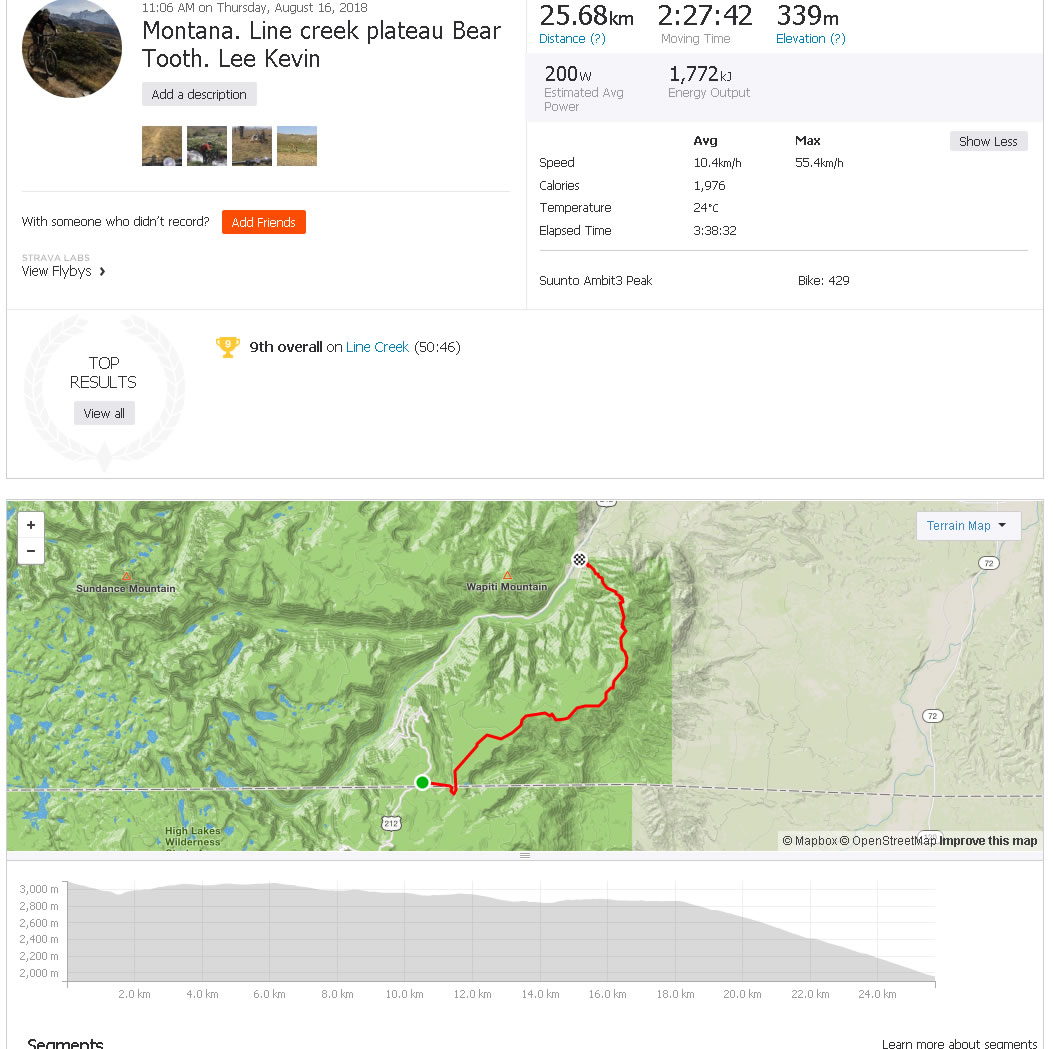
Big Snowy Mountains and the Ice Caves route
Tucked away in the Big Snowy Mountain Range near Lewiston Montana the Ice Caves route isn’t long, doesn’t involve a huge deathmarch and isn’t entirely in the alpine. It is however a gem combining a sequence of various geological features linked by climbable singletrack ascent then an entertaining, exposed and loose narrow descent. It’s a high quality trail in its own right and is further uniquely defined by running close to two year-round ice caves.
The Big Snowy’s rise only 700 – 800 m from the surrounding high plateau constituting Montana’s valleys. These mountains are a classic Montana “island range” (ie one that extrudes at seemingly random points probably as a combination of tectonic activity plus differential erosive forces). However their semi-circular cirque arrangement capped by ridges protruding from their natural ampitheater affords superlative views.
This ride is another Montana alpine classic facing closure as it has the double headed black mamba misfortune of being in a Wilderness Study Area and being proposed for Recommended Wilderness. Enjoy it while you can !
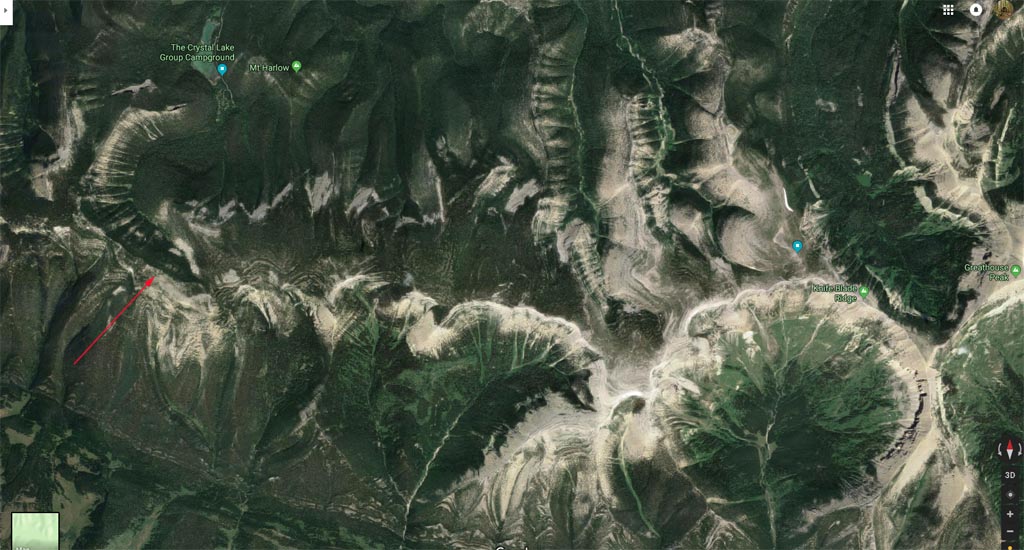
Opportunities abound for sidetrips on the Grandview Ice Caves loop. For example you can easily bike out on Knifeblade Ridge potentially to Greathouse Peak

Sunflower spectaculars on the road into the Crystal Lake campground
The Grandview Trail aka Ice Caves aka Big Snowy Mountains – Sept 16, 2018 Montana.
The Ice Caves route is “just” 19.3km and 797m elevation gain. Options exist to extend it by turning off after the climb to the top of the Big Snowy’s flat plateaus at 2650m to proceed E along Knifeblade Ridge (it’s actually quite wide) then to meander along the ridgeline towards Greathouse Peak thus adding views, distance and perhaps a tad more climbing.
The US Forest Service has clearcutted the Crystal Lake Campground and base area for forest maintenance purposes so the trailhead is somewhat blocked by fallen trees. You start off with doubletrack by the campground bathrooms which then becomes climbing singletrack nest to the lake. Junctions are well-marked with the climb up the Grandview trail signed. Plod your way up to the E-W ridgeline view. If you’re lucky you’ll see spectacular views “to the northeast are the Judith Mountains, the Mocassin Mountains to the North, the Highwoods to the Northwest, and the Little Belts to the West. On a clear day, you can even see the Crazy Mountains to the Southwest “.
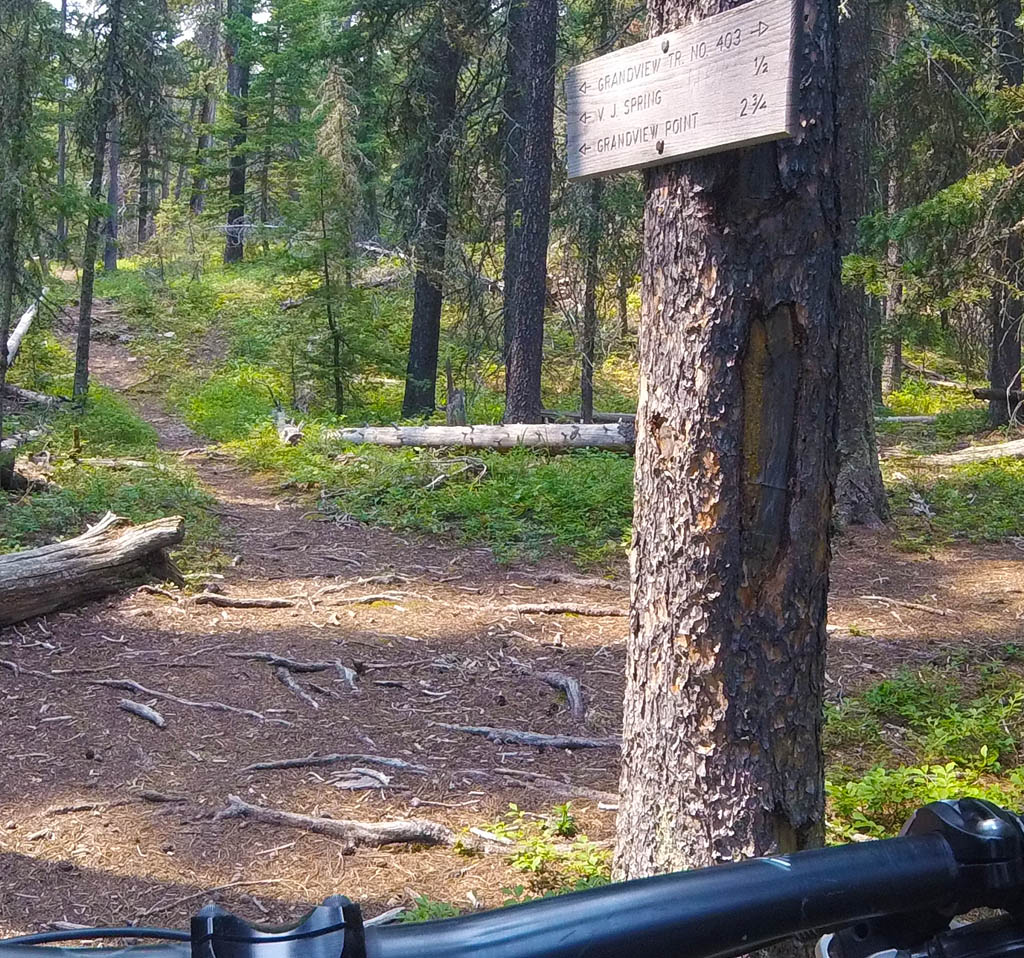
Trailhead starts at 1850m and towards its start is a gradual meandering climb
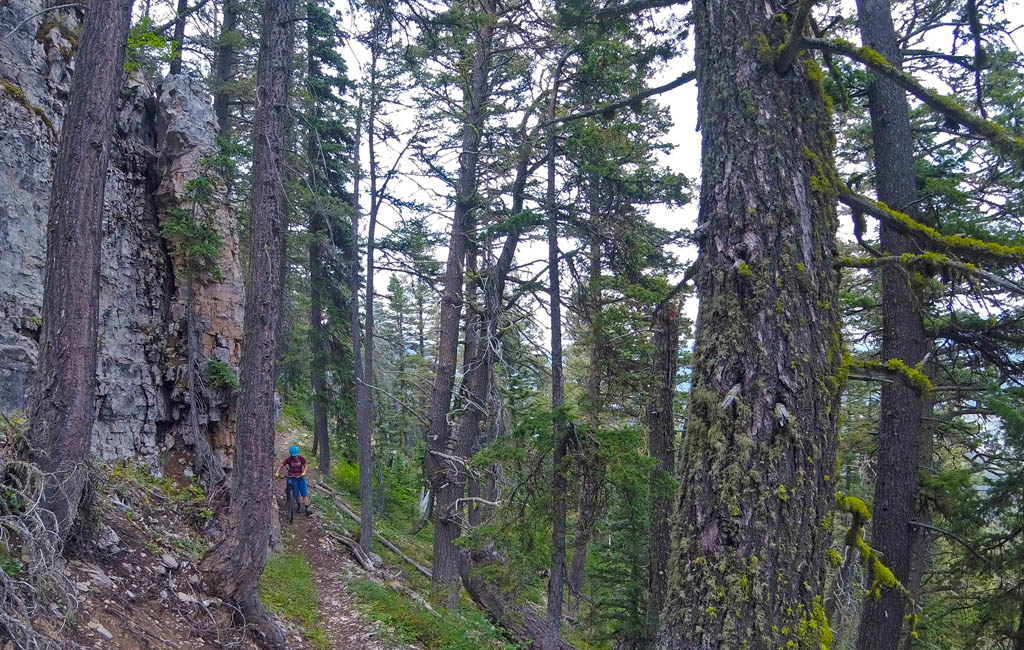
As you get closer to the (first) Grandview viewpoint at about 2100m there are rockbluffs indicating the uplifted seabed floor nature of the terrain and a gradual steepening of hte grade
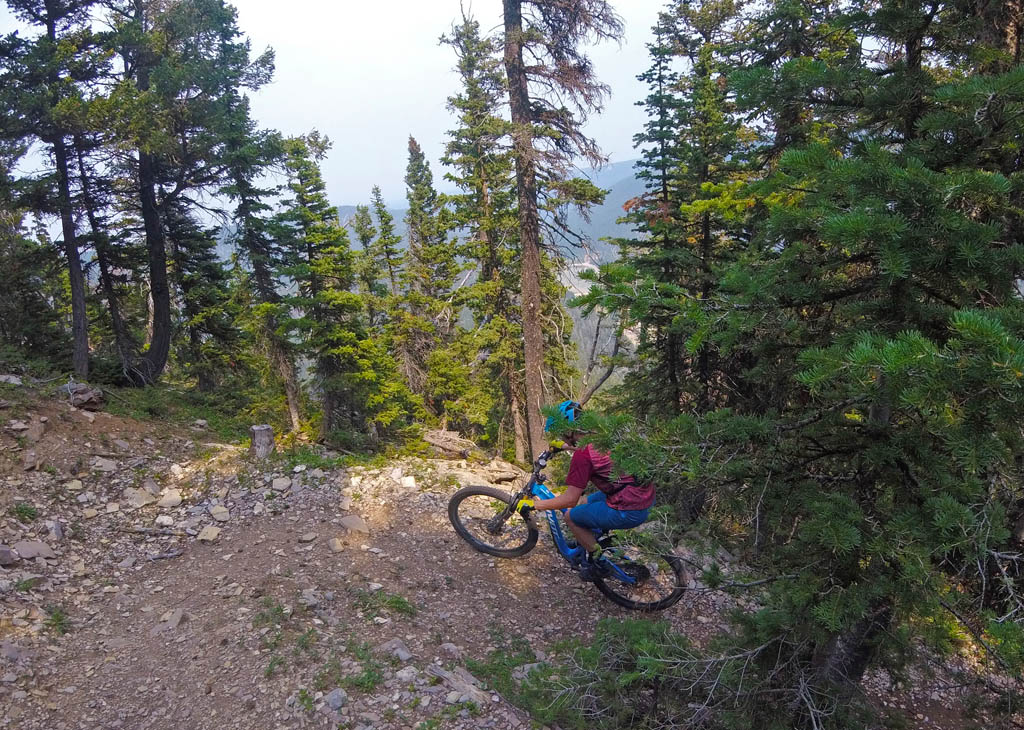
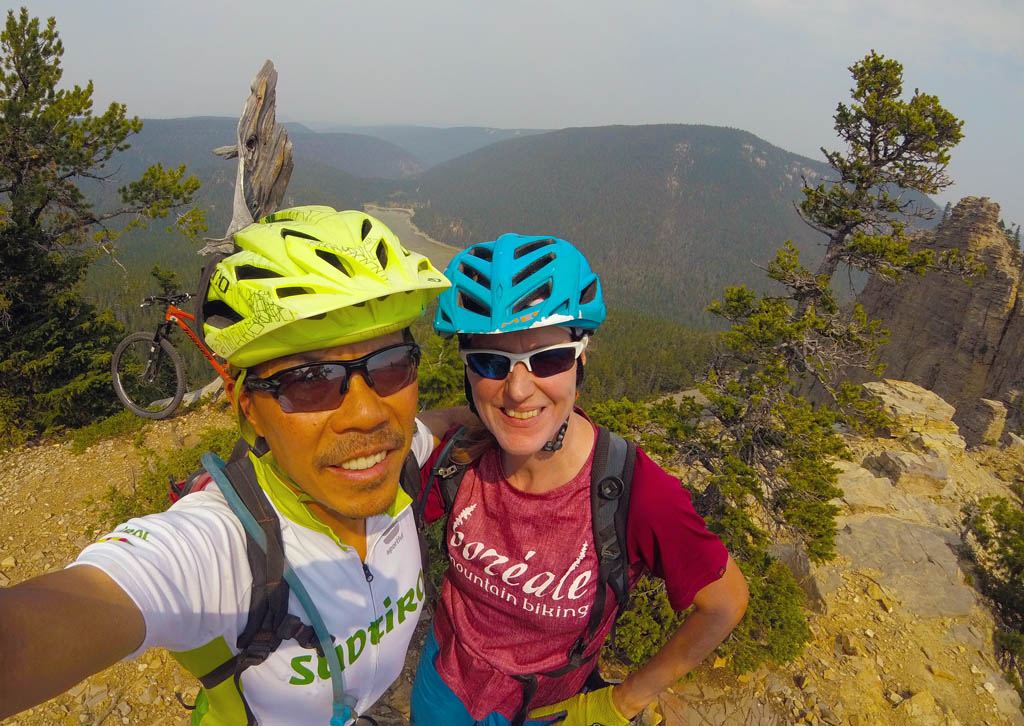
The first Grandview Viewpoint. You can see clearly to Crystal Lake
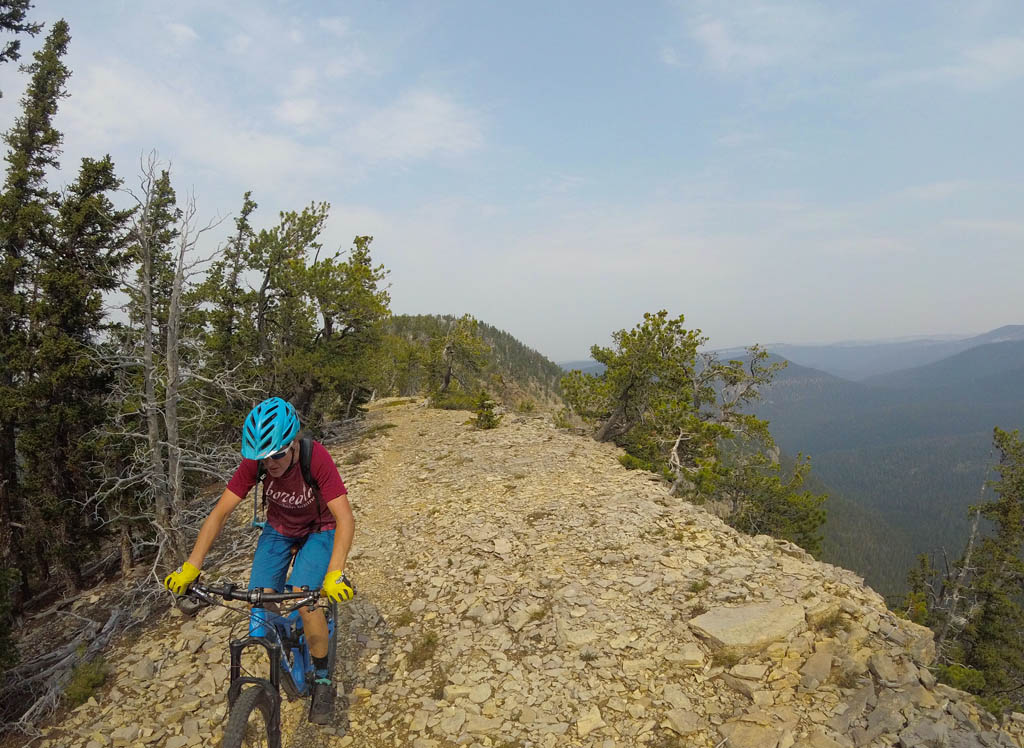
As you clear the ridgeline towards 2300m the incline steepens and the scree gets more broken. Unfortunately today we had smoke from Canadian forest fires making for sub-par views and scratchy throats
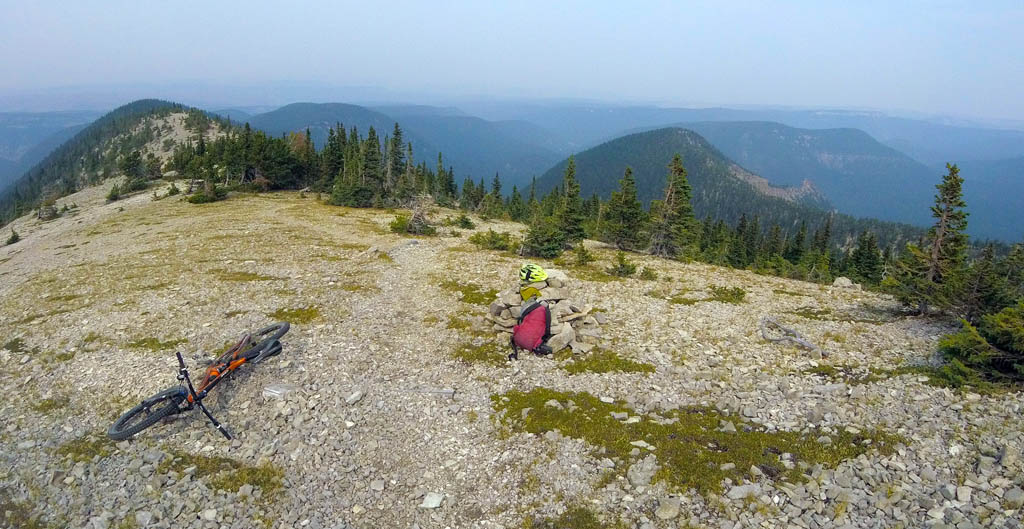
Well this would surely have been quite a view
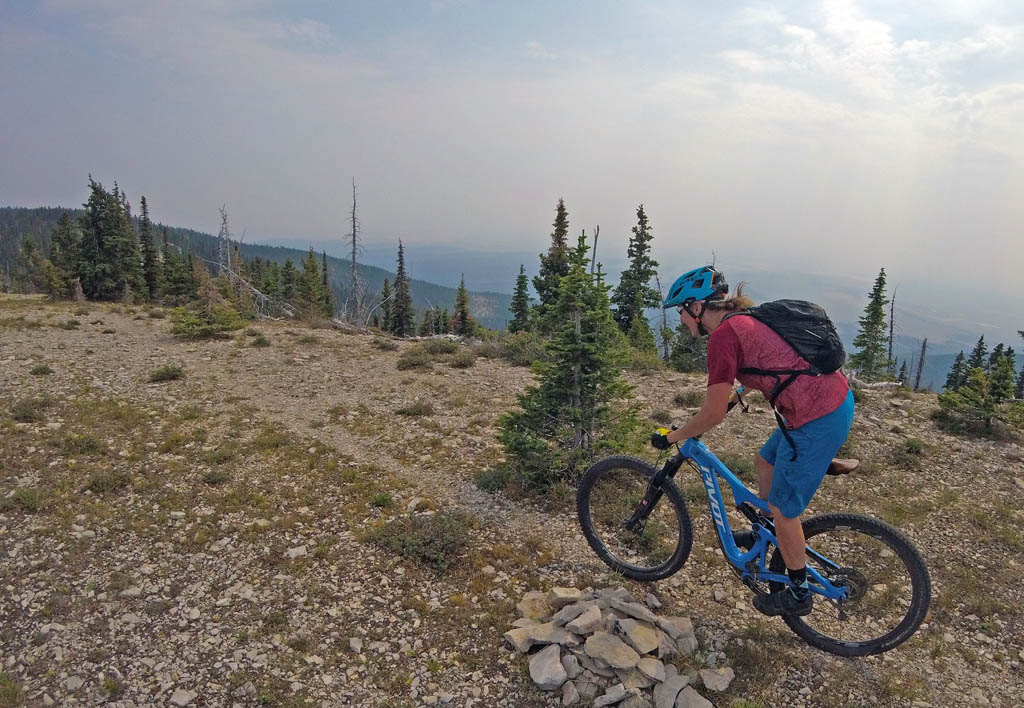 ‘
‘
At the Grandview trail highpoint of of approx 2500m the ridgeline views of the Big Snowys to the north and the Mussellshell range to the south would have been spectacular; but alas not today
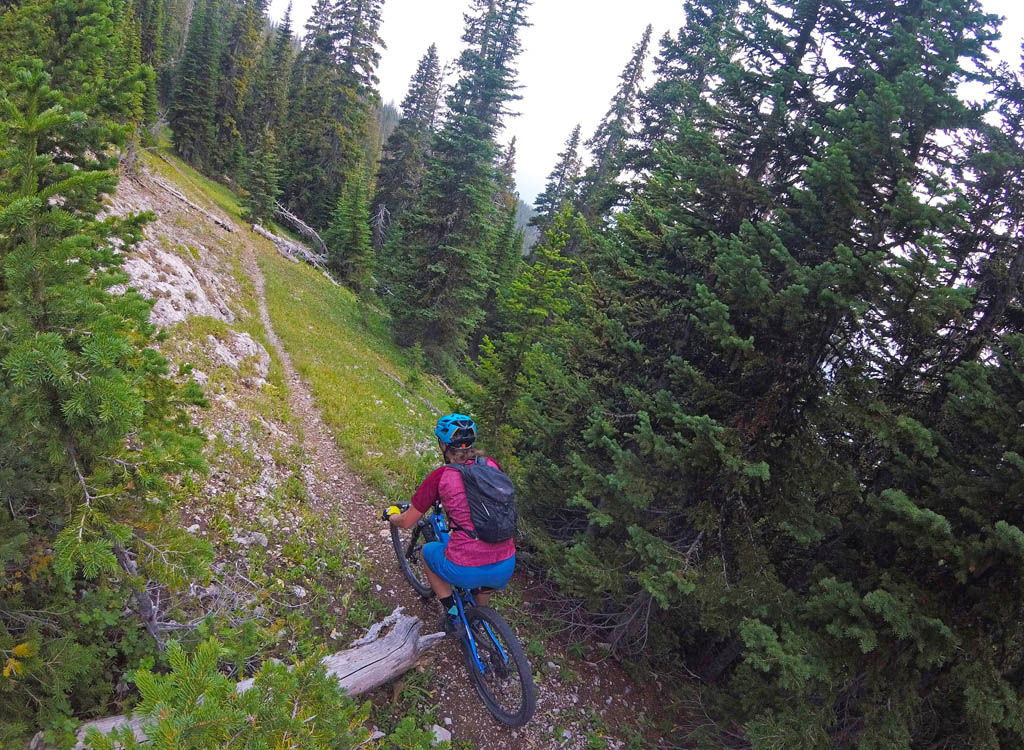
The Grandview ridgeline trail is up and down then meanders towards flats just before the Ice Caves.
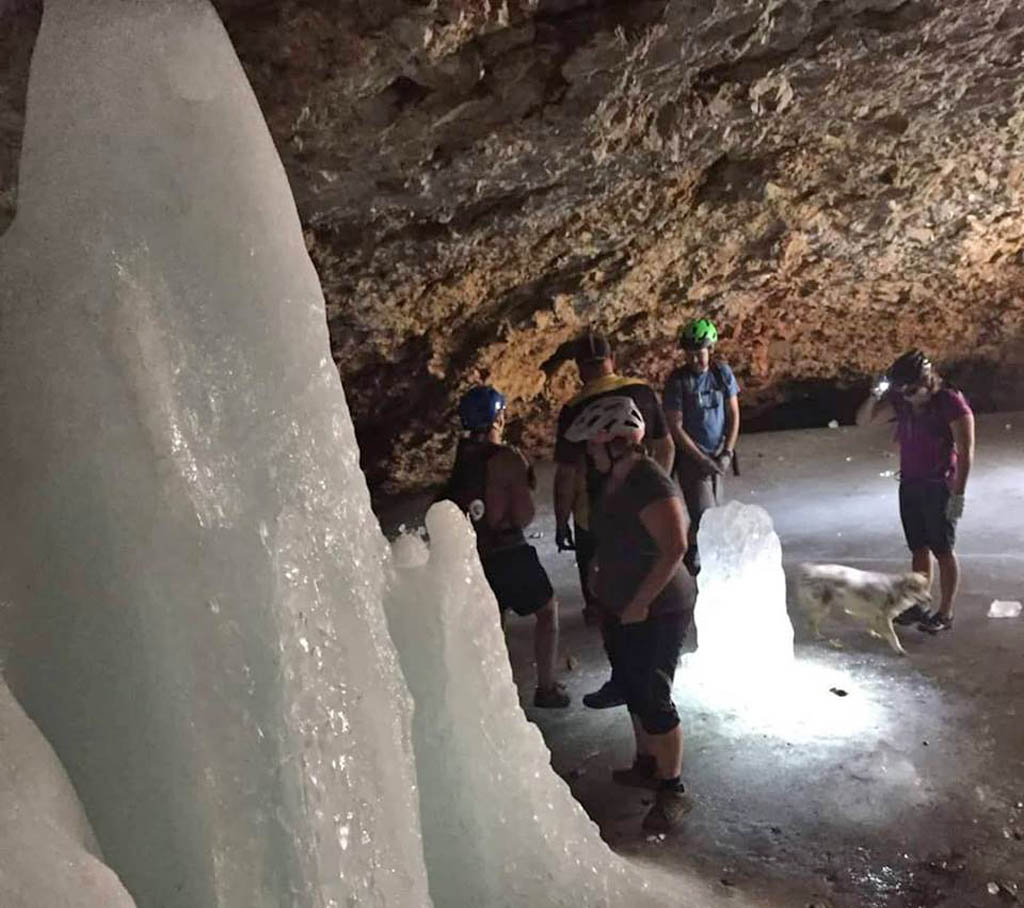
Picture from the Montana Mountain Bike Alliance. Unfortunately when we got to the Ice Caves the permanent icefeatures had dwindled in the summer heat and were less impressive
For some 2kms or so past the marked Ice Caves turnoff you’ll meander through the beginnings of some subalpine but the trail gently descends again to pine forest where you’ll see the junction towards Knifeblade Ridge marked also as 493 or “Greathouse”. From there you can do an out-and-back ridgeline meander.
Here also is the payoff of the “Ice Caves” aka Uhlhorn descent. It’s tight, it’s loose, in sections it’s exposed and got scree sections. The descent is fast but not too fast. It’s loose but not too loose. It’s twisty and turny but not too janky. In short, you’ll probably have a better than average time with the only downside being that it demands a significant amount of concentration so you may want to stop every now and then to take in the sublime views.
Maps for the area can be tricky to find since there are so many names demarcating this site (Big Snowy, Ice Caves, Grand view). Instead just look for the Crystal Lake area trail maps which show the possibilities.
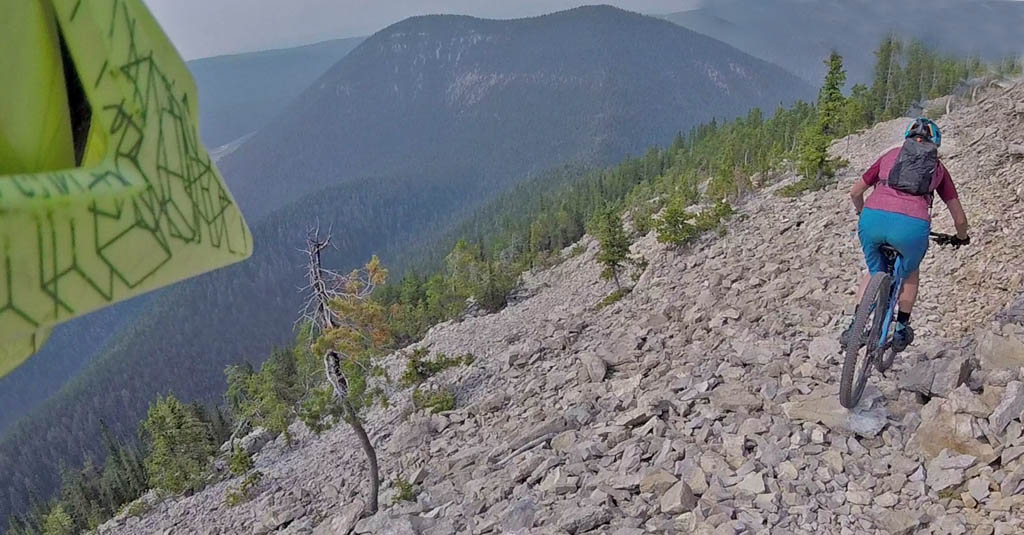
Not a descent for those who don’t like exposure or heights
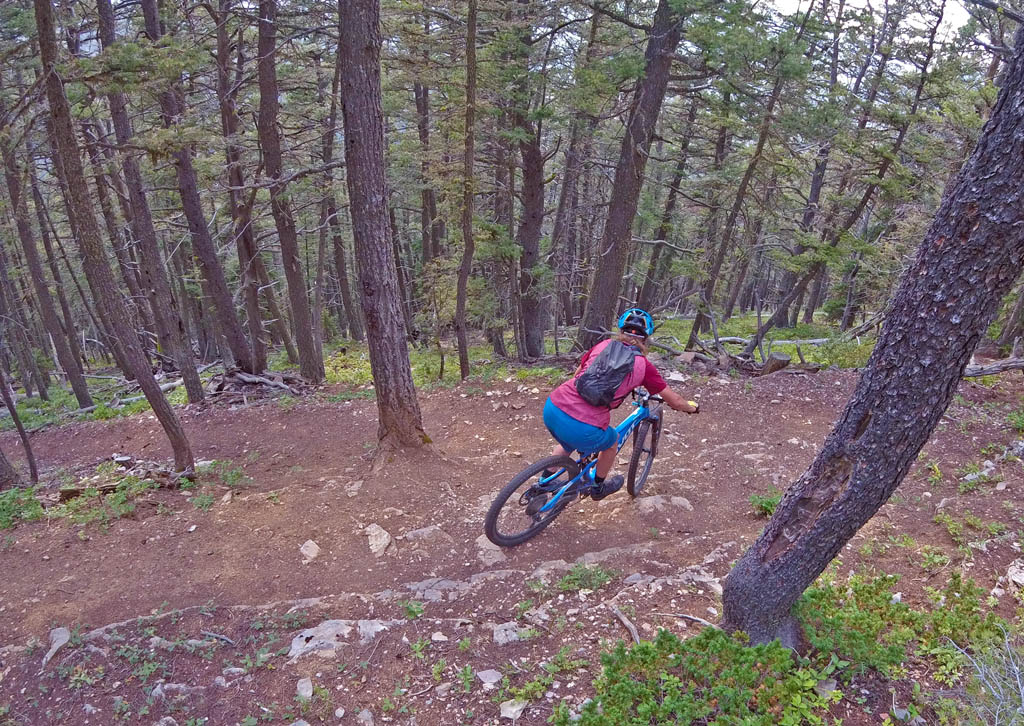
Tight switchbacks on the Ice Caves trail. Counterclockwise is definitely the way to do this. These switchbacks and the preceding scree descents would not make for a good climb.
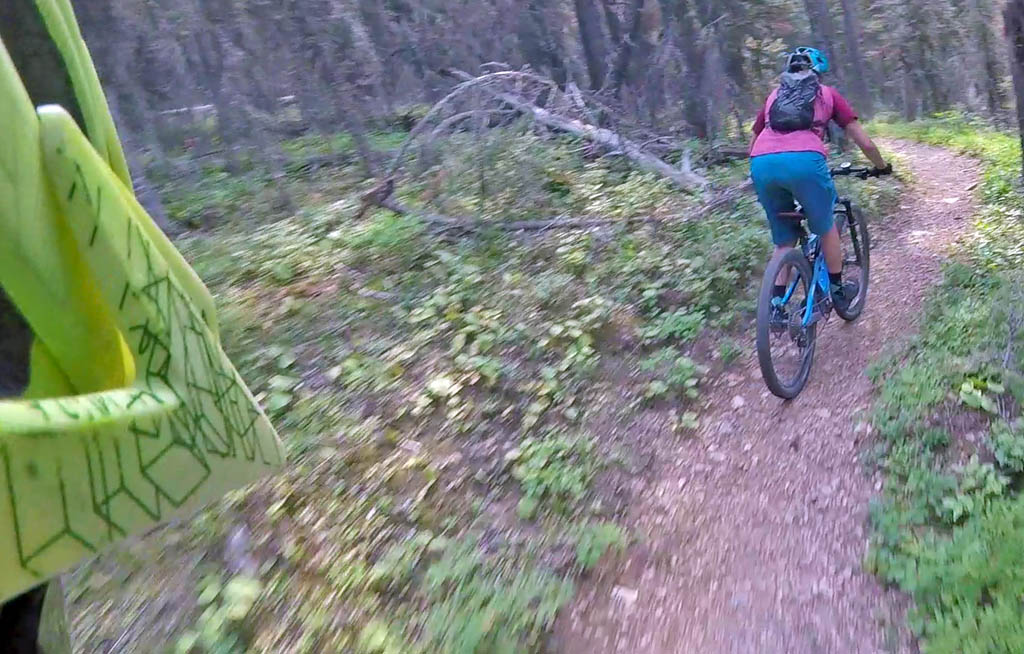
Fast and technical roots/rocks on the Ice Caves descent

Wilderness and the Big Snowy’s Ice Caves route
The Big Snowy’s aka Grandview aka Ice Caves route is administed by the Helena-Lewis and Clark National Forest. This arm of the US Forest Service is (sadly) part of US Forest Service Region 1. This is the same USFS region which caves in to the Wilderness movement at the drop of a hat. Unfortunately the Helena FS has proposed travel plan revisions. One of the options in this plan is to expand Recommended Wilderness Areas and Wilderness Study Areas to encompass the Ice Caves route. This will mean that this ride will then be forbidden for mountain-biking.
As mentioned previously in part 2 of this series, neither a RWA nor a WSA is “Wilderness” in the sense of being designated by Congress. They’re a creation of a US Forest Service bureaucrat. The “rule” that mountain-biking should be banned if an area is RWA or WSA is a creation of a US Forest Service bureaucrat. And these bureaucrats are supplicants of the Wilderness movement either co-opted by that movement or browbeaten into compliance by litigation.
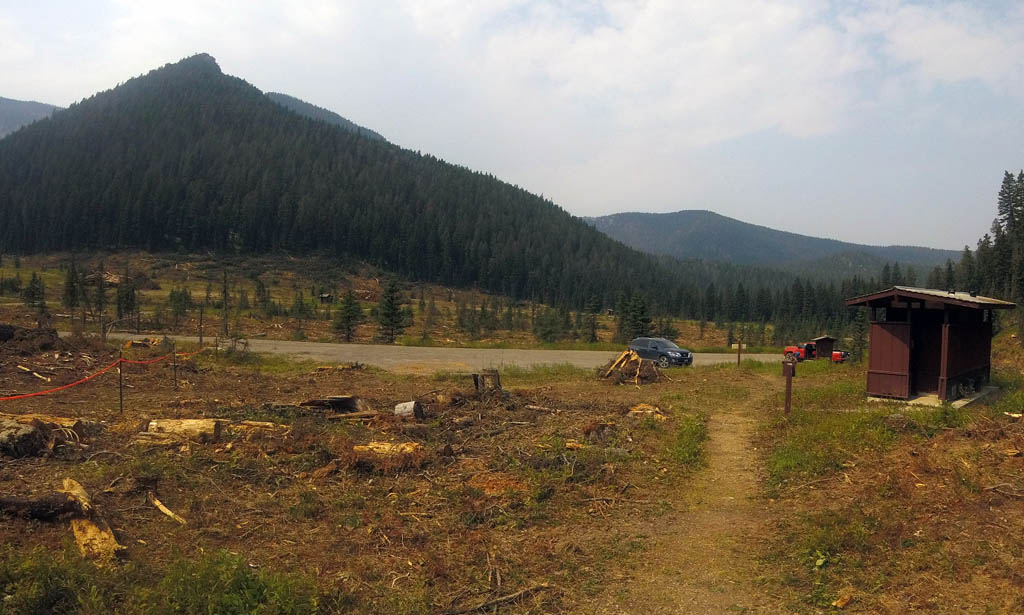
The Crystal Lake Campground was closed because the US Forest Service were busy clearcutting the forest to mitigate problem trees.
The twist in the Helena-Lewis and Clark National Forest travel plan proposal is to lay the groundwork for prohibiting mountain-biking not just in the quasi-wildernesses of RWAs and WSAs but also in IRAs (Inventoried Roadless Areas). Now one might well say, who cares what bureaucratic alphabet soup reason is dreamed up the US Forest Service to prohibit mountain-biking? A ban is a ban by any other name. However, it’s an interesting legal twist dreamed up the US Forest Service planning drones. Now a US Forest Service bureaucrat may be able to designate public land as either IRA, WSA or RWA and argue that these are quasi-wilderness lands which may one day in the future grow up to become Wilderness should be managed as Wilderness. Triple layering a trail into RWA, WSA and/or IRA status therefore puts in three ways for bikes to get banned.
Voila, mountain-biking the Big Snowy’s/Ice Caves routes will be banned.. If the trend of US Forest Service anti-bike policy continues the mountain-bike ban will extend to any trails in the Helena-Lewis and Clark National Forest areas designated as quasi/baby Wilderness. Following from that, the mountain-bike ban will then continue to any trails in US Forest Service Region 1 which could potentially be dreamed up by a bureaucrat as quasi/baby Wilderness of RWA, WSA and/or IRA. This means practically all trails in Montana, Idaho and a nice chunk of neighbouring states.
Sounds bleak? It is.
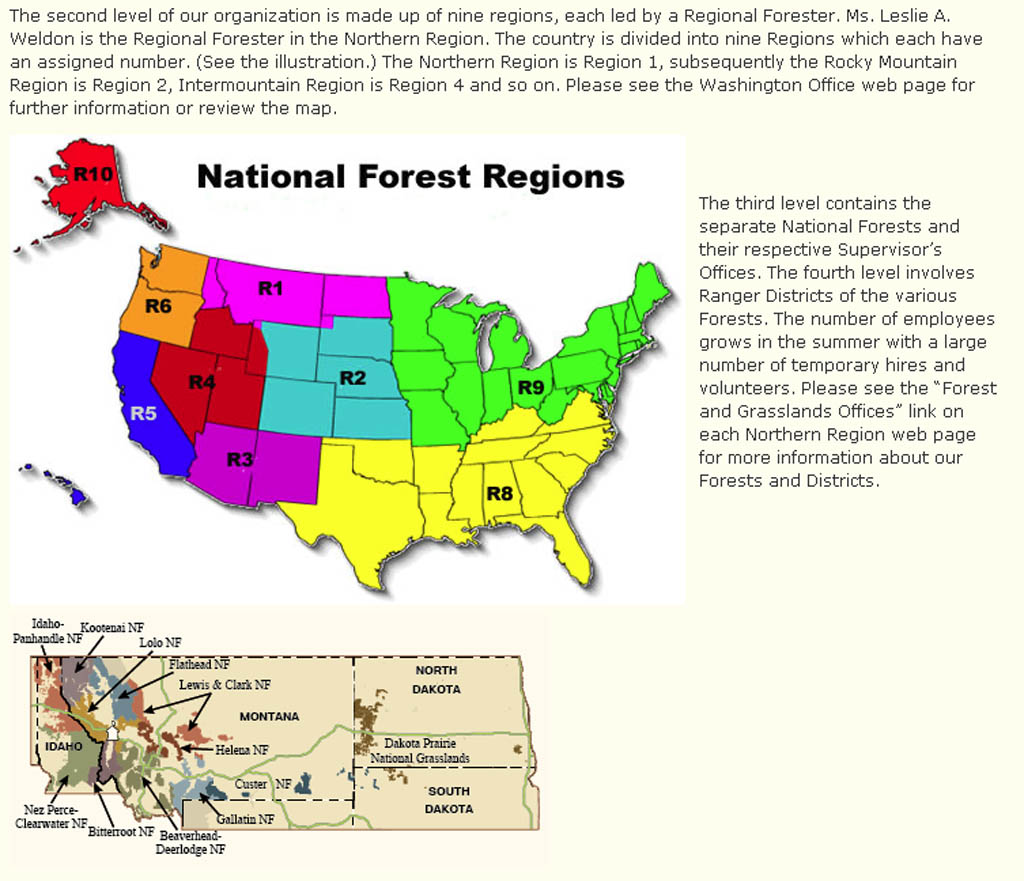
US Forest Service Region 1 and it’s anti-bike reach
Some general thoughts on road-tripping Montana
You know how how you look at awesome places to explore on a bike and you think “Well it ain’t going nowhere. Lots of time to get to it”. That isn’t the case in Montana where insanely beautiful alpine rides will be prohibited for mountain bikes in short order. This trip was about a ticklist of those trails. It meant the driving to biking ratio was more than I normally would want. But high quality alpine rides are rare beasts. It stands to reason that they’re spread out.
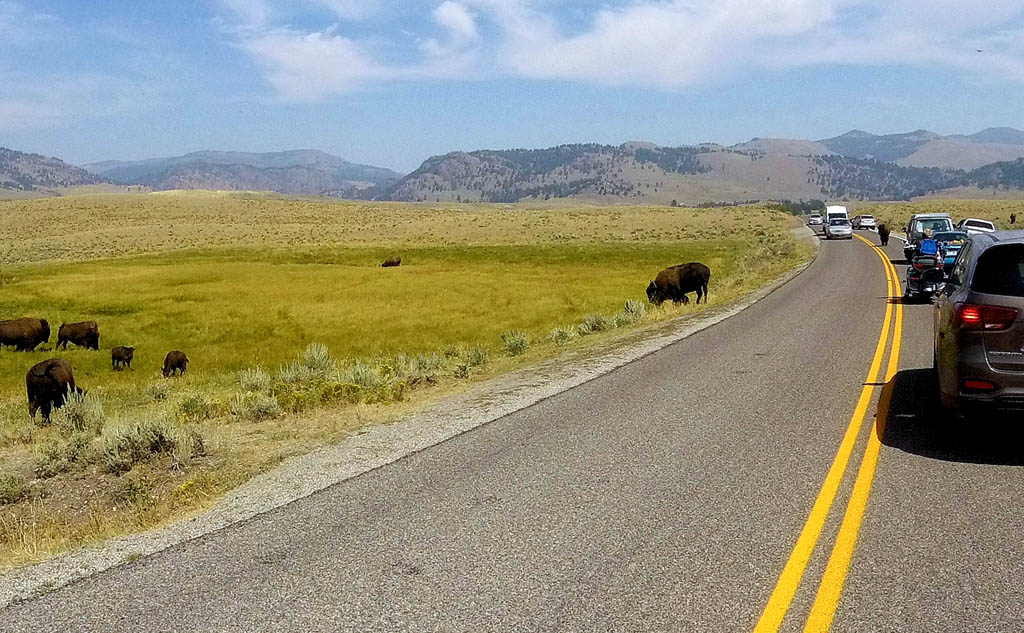 ‘
‘
The inevitable traffic jam from selfie-taking tourists gaping at Yellowstone bison as we exited the park heading back to Montana via the Beartooth Highway
With that in mind here are some general observations on Montana roadtripping
- Even by Canadian standards Montana is big! Just getting to Hamilton/Bitterroots area is past the BC/Alberta border almost to Canmore. West Yellowstone is all the way past Calgary towards Lethbridge. Red Lodge might as well be the end of the earth almost to Swift Current SK!
- Because it’s further south alpine in this area isn’t till 2500m+ (approx 300m higher than in southern Canada). This means that if you aren’t acclimatized or used to lower oxygen levels you will suffer mightily.
- As with all alpine trails they are technical and require solid all-around up and down skills. Expect punchy tech jank. Beginners will be taking their bikes for a walk.
- People tend to aggregate in cities or towns. These alpine trails (or campgrounds close to them) don’t see a lot of people. Frontcountry riders should be prepared to change their mindset and be totally self-contained and prepared to self-rescue. The latest enduro fannypack plus waterbottle will likely be insufficient
Because Montana is so big I wouldn’t do a trip like this again in a hurry. Instead I’d focus on a single region or close-together regions. The last time we were here we focused on Bozeman area rides. The next time I’m inclined to check out more of the Hamilton/Darby Bitterroots area (although watch out for Sheriff Larry Rose grrr). There’s still a ton of legal riding in the Bitterroots especially around Hamilton, Lake Como, Warm Springs/Sula. There’s also quite a bit of alpine riding in the area even with the Forest Service closures litigated by the Wilderness movement. The Lost Trail Bike Fest looks like it would be a blast.
Alternatively there’s also room for exploration centred around the Lionhead and Centennials as a central point. Or Whitefish. Or Helena proper. Or the Bridgers. Montana is a big, big state with lots of room, lots of trails and not many people. Hopefully this three-parter whets the appetite, doesn’t discourage one too much and encourages people to treasure and lobby to preserve what they have.
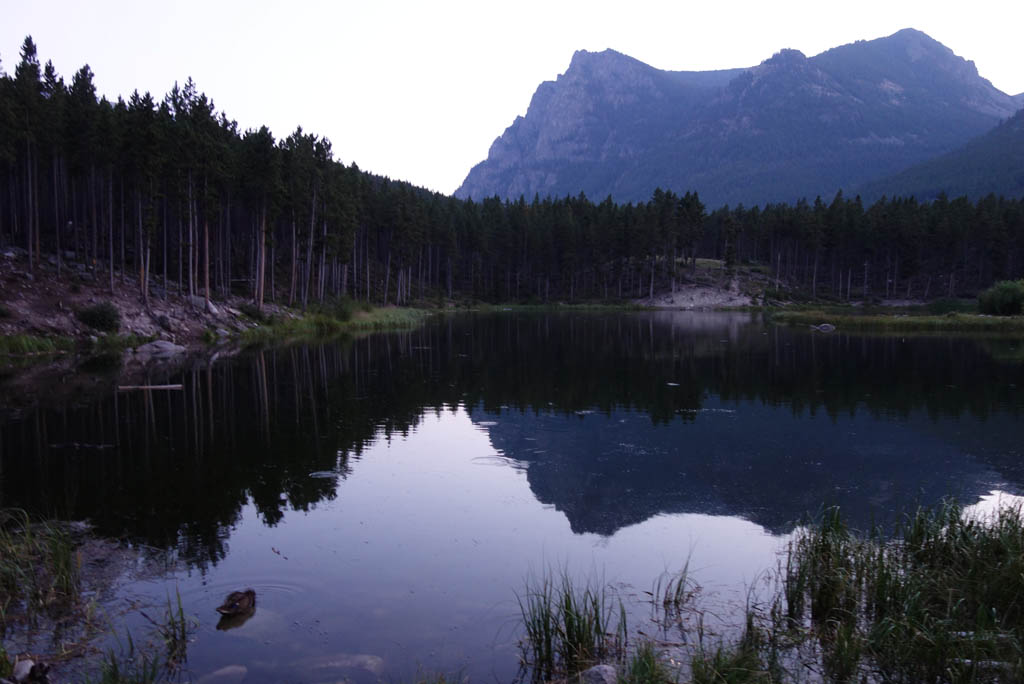
View from the Greenough Campsite towards Beartooth Pass
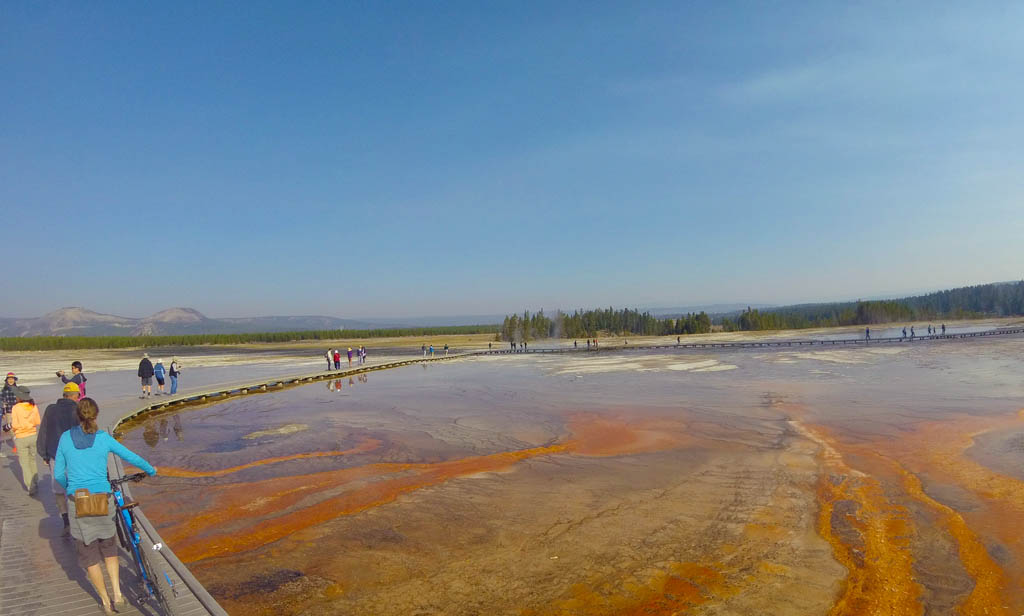
Note please we WALKED our bikes along the Grand Prismatic Springs boardwalks as we didn’t have our locks with us. To preserve Wildnerness condescencion points we also rode our bikes to the Springs from where we parked so had much more Gaia karma stored up
